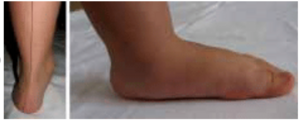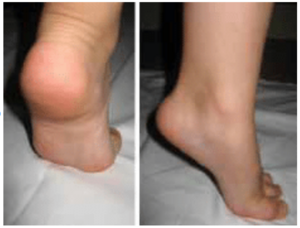Tip Toe Standing Test: Difference between revisions
No edit summary |
No edit summary |
||
| (11 intermediate revisions by the same user not shown) | |||
| Line 1: | Line 1: | ||
<div class=" | <div class="editorbox"> | ||
'''Original Editor '''- [[User:Lauren Heydenrych|Lauren Heydenrych]] | |||
'''Top Contributors''' - {{Special:Contributors/{{FULLPAGENAME}}}} | |||
</div> | |||
== Purpose == | |||
< | The purpose of a tip toe standing test is to differentiate between the two different categories of flatfoot ([[Pes Planus|pes planus]]), namely flexible flatfoot and fixed flatfoot.<ref name=":0">Rodriguez N, Volpe RG. [https://www.sciencedirect.com/science/article/abs/pii/S0891842209000731?via%3Dihub Clinical diagnosis and assessment of the pediatric pes planovalgus deformity]. Clinics in Podiatric Medicine and Surgery. 2010 Jan 1;27(1):43-58.</ref> It is important to differentiate flexible from fixed as the prognosis and intervention of the two presentations are vastly different. In addition, the presentation of a fixed flatfoot deformity flags possible underlying pathologies which could include cerebral palsy, other tone-influencing pathologies or tarsal coalition. | ||
This is an indirect, observational method of assessment.<ref name=":0" /> | |||
To further test for a flexible flatfoot, the Hubscher maneuver (or [[Jack Test|Jack's test]]) can also be done. | |||
== Technique == | == Technique == | ||
1. The patient stands on flat ground. This can be done at a wall or other place where external support can be used. | 1. The patient stands on flat ground. This can be done at a wall or other place where external support can be used. | ||
2. The patient is then asked to stand | 2. The patient is then asked to stand on tiptoe. | ||
== Result and Interpretation == | |||
In a '''flexible flatfoot''' the heel will turn inwards (varus position) and the medial arch will become apparent. | |||
In '''fixed flatfoot,''' the medial longitudinal arch will remain unobservable.<ref>Alazzawi S, Sukeik M, King D, Vemulapalli K. [https://www.ncbi.nlm.nih.gov/pmc/articles/PMC5241541/ Foot and ankle history and clinical examination: A guide to everyday practice]. World Journal of Orthopedics. 2017 Jan 18;8(1):21.</ref>[[File:Medial arch collapse.png|Figure A: Medial Arch collapse in weight bearing. During weight-bearing, the disappearance of the medial longitudinal arch of the foot is seen. On posterior view, angling of the Achilles tendon (hindfoot valgus) is observed.|alt=|left|thumb]] | |||
{| | |||
|+ | |||
! | |||
![[File:Tiptoe test.png|thumb|Figure B: Tiptoe test. While raising up on tiptoe, reconstruction of the medial longitudinal arch collapsed during weight-bearing is observed.|alt=|center]] | |||
|} | |||
==== Performance of Tip Toe Standing Test ==== | |||
{{#ev:youtube|nolevVWzdio|500}}<ref>Dr. Estefania Birrer Gonzalez. Toe Standing Test For Flexible Flatfoot. Available from: https://www.youtube.com/watch?v=nolevVWzdio [last accessed 16/07/2022]</ref> | |||
== References == | == References == | ||
<references /> | <references /> | ||
[[Category:Foot]] | |||
[[Category:Foot - Assessment and Examination]] | |||
[[Category:Paediatrics - Assessment and Examination]] | |||
Latest revision as of 19:07, 3 September 2022
Original Editor - Lauren Heydenrych
Top Contributors - Lauren Heydenrych
Purpose[edit | edit source]
The purpose of a tip toe standing test is to differentiate between the two different categories of flatfoot (pes planus), namely flexible flatfoot and fixed flatfoot.[1] It is important to differentiate flexible from fixed as the prognosis and intervention of the two presentations are vastly different. In addition, the presentation of a fixed flatfoot deformity flags possible underlying pathologies which could include cerebral palsy, other tone-influencing pathologies or tarsal coalition.
This is an indirect, observational method of assessment.[1]
To further test for a flexible flatfoot, the Hubscher maneuver (or Jack's test) can also be done.
Technique[edit | edit source]
1. The patient stands on flat ground. This can be done at a wall or other place where external support can be used.
2. The patient is then asked to stand on tiptoe.
Result and Interpretation[edit | edit source]
In a flexible flatfoot the heel will turn inwards (varus position) and the medial arch will become apparent.
In fixed flatfoot, the medial longitudinal arch will remain unobservable.[2]
Performance of Tip Toe Standing Test[edit | edit source]
References[edit | edit source]
- ↑ 1.0 1.1 Rodriguez N, Volpe RG. Clinical diagnosis and assessment of the pediatric pes planovalgus deformity. Clinics in Podiatric Medicine and Surgery. 2010 Jan 1;27(1):43-58.
- ↑ Alazzawi S, Sukeik M, King D, Vemulapalli K. Foot and ankle history and clinical examination: A guide to everyday practice. World Journal of Orthopedics. 2017 Jan 18;8(1):21.
- ↑ Dr. Estefania Birrer Gonzalez. Toe Standing Test For Flexible Flatfoot. Available from: https://www.youtube.com/watch?v=nolevVWzdio [last accessed 16/07/2022]








